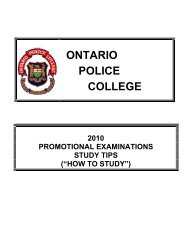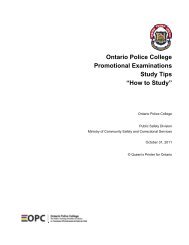General Study Guide - Ontario Police College
General Study Guide - Ontario Police College
General Study Guide - Ontario Police College
You also want an ePaper? Increase the reach of your titles
YUMPU automatically turns print PDFs into web optimized ePapers that Google loves.
Very approximate correlations between wavelengths and colour:<br />
(1 nm = 1 nanometre = one-billionth of a metre; 1 mm = 1,000,000 nm)<br />
Luminescence -<br />
1. The emission of light that does not derive energy from the temperature of the emitting<br />
body, as in phosphorescence, fluorescence, and bioluminescence. Luminescence is caused<br />
by chemical, biochemical, or crystallographic changes, the motions of subatomic particles, or<br />
radiation-induced excitation of an atomic system.<br />
2. The light so emitted.<br />
Photoluminescence -<br />
A luminescence excited in a body by some form of electromagnetic radiation incident on the body.<br />
The term photoluminescence is generally limited to cases in which the incident radiation is in the<br />
ultraviolet, visible, or infrared regions of the electromagnetic spectrum.<br />
Photoluminescence may be either a fluorescence or a phosphorescence, or both. Energy can be<br />
stored in certain luminescent materials by subjecting them to light or some other exciting agent,<br />
and can be released by subsequent illumination of the material with light of certain wavelengths.<br />
This type of photoluminescence is called stimulated photoluminescence. See also Fluorescence;<br />
Luminescence; Phosphorescence.<br />
Chemoluminescence -<br />
Emission of light as a result of a chemical reaction. Different chemicals require illumination with<br />
light from different regions of the spectrum to excite fluorescence and the wavelength (colour) of<br />
the emitted light varies from one chemical to another.<br />
Fluorescence -<br />
400 nm = Violet (Higher energy)<br />
450 nm = Blue<br />
500 nm = Blue/Green<br />
550 nm = Green<br />
600 nm = Yellow/orange<br />
650, 700nm = Red (Lower energy)<br />
Fluorescence is the property that some chemicals possess of being able to absorb light of a specific<br />
colour and then convert some of the absorbed energy into light of a different colour of longer<br />
wavelength. The time delay between absorption and emission is only a fraction of a second (less<br />
than 10 seconds) so that when the illuminating light is removed the emission apparently stops.<br />
Typically, light in the ultraviolet, blue or green parts of the spectrum is used to excite fluorescence<br />
which may result in the emission of light in the yellow, orange, red or infrared parts of the<br />
spectrum. (Because some of the energy has been lost before emission takes place, the light emitted

















